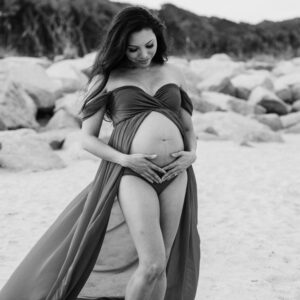If you’re here because your baby or loved one received a Trisomy 13 diagnosis or positive screening, first off, I want to tell you I’m sorry for the grief and wave of emotions you’re probably feeling. As the mother of a child who passed from Trisomy 13, I know how tough the road ahead can be. There are so many decisions to make, and I want you to know that no matter what decisions you make, trust that YOUR decisions are the RIGHT decisions. There are no right or wrong decisions. Your decisions were made with love, and any decision you make in love for your child is the right one.

Trisomy 13 is incredibly rare. About 1 out of every 10,000 babies are born with Trisomy 13, and it can feel isolating when you don’t know anyone who’s been through a similar diagnosis. If you haven’t met any families or children with Trisomy 13, I hope you reach out to me or visit our resources page to connect with families who’ve dealt with similar diagnoses. The medical field will help you by giving you facts about the diagnosis. However, what the medical field usually lacks is the experience of raising a Trisomy 13 child. Many medical professionals never met a child with Trisomy 13 and have never seen how happy these children are or the joy they bring all who meet them. Your doctor also does not have the personal experience of carrying and continuing a Trisomy 13 pregnancy, which can be incredibly beautiful regardless of the outcome. So, although medical professionals are an excellent resource, they are not the ONLY resource to guide you on this journey.
What is Trisomy 13?
Typically, individuals have 23 pairs of chromosomes, which means they have a total of 46 chromosomes (23 pairs of chromosomes x 2 chromosomes per pair = 46 chromosomes). The first 22 pairs of chromosomes are labeled with numbers, 1 through 22. The last pair of chromosomes are the sex chromosomes, which are either XX for females or XY for males.
Trisomy 13, also known as Patau’s Syndrome, is a chromosomal abnormality. Typically, individuals carry 2 chromosomes in each in a pair. Individuals with Trisomy carry an extra chromosome, meaning that instead of having 2 chromosomes in a pair, they have three. The most common Trisomy is Down Syndrome (also known as Trisomy 21). People with Down Syndrome have an extra 21st chromosome. Individuals with Trisomy 13 carry an extra 13th chromosome.
Types of Trisomy 13:
There are three forms of Trisomy 13: full, partial and mosaic.
Full Trisomy 13 means all the cells in the body have an extra full copy of the 13th chromosome. Most Trisomy 13 cases are Full Trisomy 13.
Partial Trisomy 13 means cells contain an extra 13th chromosome, but the extra chromosome isn’t a complete, full copy of the chromosome. Instead, the extra chromosome only contains a partial piece of the 13th chromosome.
Mosaic Trisomy 13 means some cells in body have an extra 13th chromosome, while the rest of the cells do not have the extra chromosome.
TRANSLOCATION:
You might hear the word “translocation” when speaking about Trisomy 13. A translocation occurs when a piece of a chromosome (or the entire chromosome) gets attached to another chromosome1. In Trisomy 13, a translocation means the entire extra 13th chromosome or a piece of it is attached to another chromosome.
Is Trisomy 13 passed to the child from the parent?
Usually, no. 95% of Trisomy 13 cases are not inherited from either parent. However, 5% of Trisomy 13 cases are inherited by a parent who is a carrier of a balanced translocation1. A balanced translocation occurs when the correct number of chromosomes are present, but part of a chromosome is broken off and attached to another chromosome2. Genetic testing will need to be done to determine if a parent is a carrier of a balanced translocation.

Abnormalities:
When it comes to abnormalities and symptoms, you need to understand that the severity of Trisomy 13 abnormalities occurs over a spectrum. Each Trisomy 13 baby is unique. Some babies have milder symptoms, while others can have severe abnormalities.
In our experience, our doctors could not tell us the severity of our daughter’s condition until she was born and assessed at birth. Ultrasounds are fairly accurate, but they cannot not predict (with certainty) the baby’s progression, and certain things cannot be seen on an ultrasound.
Common in Trisomy 13:3-4
- Congenital heart defect 80%
- Holoprosencephaly 50-70% (failure of forebrain to divide properly)
- Cleft lip and or palate or both 60%
- Ocular (eye) abnormalities >50% such as small or absent eyes
- Brian abnormalities >50%
- Hernias >50%
- Microcephaly >50%
- Dextrocardia >50%
- Polydactyly >50% (extra finger or toe)
- Posterior prominence of heels >50%
Less Common in Trisomy 13:3-4
- Meningomyelocele (form of spina bifida) <50%
- Radial Aplasia (lack of part of wrist bone) <50%
- Kidney defects 30%
- Skin defects of the scalp 20%
- Omphalocele 10%
Life expectancy:
I had a Maternal Fetal Medicine doctor tell me no Trisomy 13 baby ever survived past a year. This statement is simply not true. Although rare, I’ve personally met Trisomy 13 individuals and parents of Trisomy 13 children who lived into or beyond their teenage years. Only about 10% of babies diagnosed with Trisomy 13 survive until their first birthday, but if they make it to their first birthday, they have a good chance of surviving until their 5th birthday.
Although the chances of survival are small, there’s still a chance. And you’ll never know what the future holds unless you take that chance. One of my favorite quotes is “You miss 100% of the shots you don’t take.” -Wayne Gretzky
Here are the stats:5
- 75% of babies born with Trisomy 13 survive past one day.
- Of those who survive one day, 58% survive one week.
- Of those who survive one week, 59% survive 28 days.
- Of those who survive 28 days, 45% will see their first birthday.
- Of those who make it to one year, 82% survive to or beyond their 5th birthday.
Termination versus Continuing Pregnancy

The decision to terminate or continue the pregnancy is very personal. This is one of the most important decisions a parent will ever make for their child, and it should not be taken lightly. As I mentioned earlier, the medical community is one of your most important resources, BUT they are not the ONLY resource. My hope is that parents get a complete picture of the situation before making their decision. Other families have dealt with a Trisomy 13 diagnosis and have subsequently undergone termination, miscarriage, stillbirth, infant loss, or raising a Trisomy 13 child. I urge you to reach out to these families for insight.
I think it’s important to get different perspectives on the matter. However, I caution you on depending too much on others’ advice. This decision is 100% yours. You, as the parent, are the person who must live with this decision…not your doctor, not your friends, not other Trisomy 13 families. No one but you bears the responsibility of this choice. No matter what decision you make, it will be the right one when it is made with love.
Here are the stats on termination and pregnancy continuation:
- 89% pregnancies diagnosed with Trisomy 13 undergo termination6
- 61% of parents felt pressured to terminate7
Of those who continued pregnancy:
- Half of parents thought caring for a disabled child was tougher than expected.3
- Despite the grim outcome of most Trisomy 13 diagnoses and difficulty of care, 89%3 – 97% of parents who chose not to terminate see their child as happy and consider the experience enriching regardless of how long or short their child lived.8
SOURCES:
- Virginia Department of Health. “Trisomy 13.” Trisomy 13, www.vdh.virginia.gov/content/uploads/sites/36/2016/11/Trisomy-13.pdf. Accessed 2 Nov. 2022.
- Danielsson, Krissi. “Balanced Translocation and Recurrent Miscarriage.” Verywell Family, 18 May 2020, www.verywellfamily.com/balanced-translocation-and-recurrent-miscarriage-2371840.
- Support Organization for Trisomy 18, 13 and Related Disorders. “What Do We Know Now About Trisomy 13?” What Do We Know Now About Trisomy 13?, 2018, trisomystage.wpenginepowered.com/wp-content/uploads/2020/06/What-do-we-know-now-T13-English.pdf.
- Ann, Barnes, and John Carey. “Care of the Infant and Child With Trisomy 18 or Trisomy 13.” “The Care Book” for Families, 4th ed., Omaha, NE, Munroe-Meyer Institute For Genetics and Rehabilitation University of Nebraska Medical Center, 2018, trisomystage.wpenginepowered.com/wp-content/uploads/2020/01/Carebook-3-22-2018-English.pdf.
- Meyer, Robert E., et al. “Survival of Children With Trisomy 13 and Trisomy 18: A Multi-State Population-Based Study.” American Journal of Medical Genetics, Dec. 2015, https://doi.org/10.1002/ajmg.a.37495.
- Cavadino, Alana, and Joan Morris. “Revised Estimates of the Risk of Fetal Loss Following a Prenatal Diagnosis of Trisomy 13 or Trisomy 18.” American Journal of Medical Genetics, Mar. 2017, https://doi.org/10.1002/ajmg.a.38123.
- McCaffrey, Martin. “Dr. Martin McCaffrey on unborn children with life limiting conditions.” YouTube, 28 September 2016, www.youtube.com/watch?v=mkdzy9bWW3E.
- Janvier, Annie, et al. “The Experience of Families With Children With Trisomy 13 and 18 in Social Networks.” Pediatrics, vol. 130, no. 2, Aug. 2012, https://doi.org/10.1542/peds.2012-0151.
